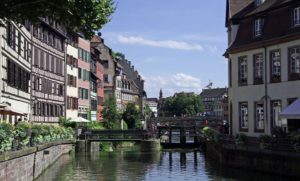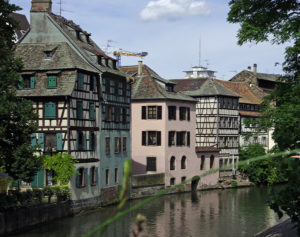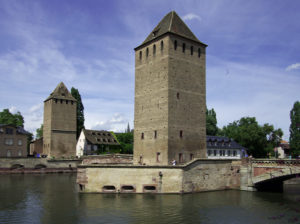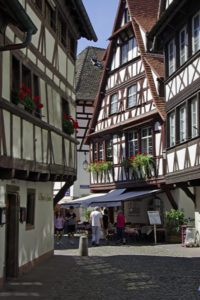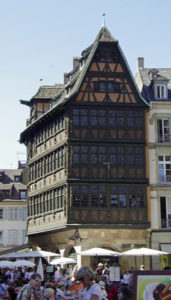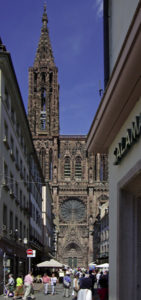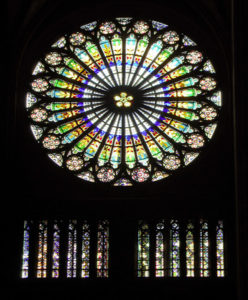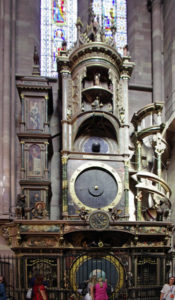The River Rhine is the boundary between French Strasbourg and German Kehl. The river cruises berth at Kehl, but nearly everyone heads into Strasbourg.
The area has changed hands several times between France and Germany and Strasbourg is a a mix of both German and French architecture. It is now the seat of the Council of Europe, the European Parliament and the European Court of Rights. It is also a popular tourist destination with its beautifully preserved historic centre that is free of traffic. This is a city you have to walk, unless you take the tourist train or a canal boat cruise.
Entry to the medieval city was guarded by four massive towers connected by bridges over the River Ill. The towers were covered by wooden canopies to protect the soldiers.Although these were removed in the C18th, the bridge is still known as the Ponts Couverts, or covered bridge. To the west of them is the Vauban Dam. This was built in 1686 by the military engineer Vauban, who considered the city defences to be inadequate. He built a dam across the river which made it possible to flood the land to the south of the city making it impassable to enemy attack. An enclosed corridor links the two banks of the river. An extra level was added to the structure in 1865and is now a panoramic terrace, with good views of Petite France.
The core of the city is the World Heritage site of Grand Ile, bordered by the River Ill and the Canal du Faux-Rempart. It is linked to the rest of the city by 21 bridges and footbridges. To the west is Petite France, a network of canals and bridges which was originally the tannery district. The houses are recognised by their open galleries below the roof which were used for drying the skins.
Leading from the canals is a network of narrow streets lined with C18th town houses and other public buildings. Probably the most photographed is the C15th timber frame Maison Kammerzell near the cathedral, with its ornate carvings and leaded windows.
The “Cathedral”:http://wasleys.org.uk/eleanor/otherholidays/rhine/c_strasbourg/cathedral/index.html has been described as one of the most beautiful Gothic cathedrals in Europe. Most of it was built in the C13th although parts of the original C12th building survive at the east end. When the tower was built it was the tallest building in the world. it is still the sixth tallest church in the world.
The very ornate west front has three doorways decorated with hundreds of statues. The stained glass windows contain brightly coloured medieval glass. The astronomical clock is one of the largest in the world and dates from 1571 although the mechanism had to be replaced in the C19th.
Opposite the Cathedral is the C18th Palais Rohan built for Cardinal Armand-Gaston de Rohan-Soubise, Prince-Bishop of Strasbourg and designed to upstage the great Parisian mansions. It now houses three museums, archaeology, decorative and fine arts.
We only had three hours in Strasbourg and hardly scratched the surface. As well as Palais Rohan, there is the museum in Maison de l’Oeuvre Notre Dame with Romanesque, Gothic and Renaissance sculpture, including many originals from the cathedral as well as C15th paintings and stained glass. The Alsatian Museum is the folk museum set in C16 & C17th buildings and covers folk lore and rural life. The History Museum in an old slaughterhouse covers the history of Strasbourg from its beginnings as a Roman military camp.
There is the Botanic Gardens and also the Jardin des Deux Rives along the banks of the Rhine and linked to the German town of Kehl by a new footbridge.
The historic centre of Strasbourg is very photogenic but you are sharing it with a lot of other people.
There are more pictures “here.”:http://wasleys.org.uk/eleanor/otherholidays/rhine/c_strasbourg/city/index.html
